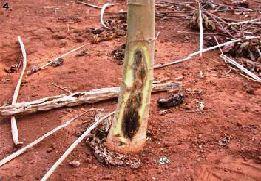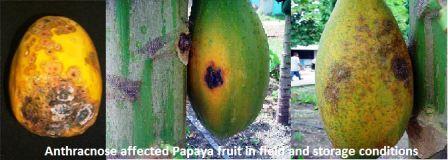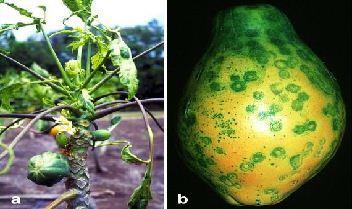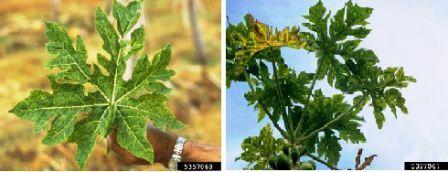Papaya : Diseases and Symptoms
Papaya : Diseases and Symptoms
Foot rot of papaya
Disease symptoms It is characterized by the appearance of water-soaked patches on the stem near the ground level.
It is characterized by the appearance of water-soaked patches on the stem near the ground level.- These patches enlarge rapidly and girdle the stem, causing rotting of the tissues, which then turn dark brown or black. Such affected plants withstand strong wind and topple over and die.
- If the disease attack is mild, only one side of the stem rots and the plants remain stunted.
- Fruit if formed are shriveled and malformed. Gradually the plant dies.
- Resting spore, Oospore, germinates and release zoospores which along with irrigation water spread throughout the field.
- High relative humidity and rainy condition favors the severe disease development in sick soil.
Anthracnose
Disease symptoms- Disease occurs both in field and in storage conditions.
- The spots on fruits first appear as brown superficial discolouration of the skin which develops into circular, slightly sunken areas and 1 to 3 cm in dia.
- Gradually the lesions coalesce and sparse mycelia growth appears on the margins of the spots.
- Under humid conditions, an encrustation of salmon pink spores is released.
- Infection at early stages of fruit results in mummification and deformation.

- The disease is spread through wind-borne conidia.
- Conidia are also spread by rain splashes.
- Severity of the disease on foliage is increased under conditions of excessive moisture. Lesions develop more slowly on the immature fruits than on the mature fruits.
- High relative humidity coupled with higher temperatures favour disease development. Maximum disease development takes place at about 26°C under wet weather condition.
Powdery mildews
Disease symptoms- On the undersurface of disease leaves are found patches of whitish powder growth.
- On upper surfaces, leaves at the infection site show blotches of yellow or pale green usually near vein, surrounded by normally colored tissue.
- Occasionally, fungus may attack the stem of young seedling when grown under reduced light condition. The spots enlarge and cover the entire leaf area. Severely infected leaves may become chlorotic and distorted before falling. Affected fruits are small in size and malformed.
- Fungus grow superficially on the undersurface of the leaves with drawing nutrients from the cell of leaf surface by specialized absorbing structure known as haustoria.

- The powdery mildew fungus overwinters in dormant buds. When conditions are favorable for growth of the fungus in spring, spores are produced, released, and cause new infections. Secondary spread of the disease can occur if spores are produced in these new infections
- The development of powdery mildew in papaya is favour by relative humidity around 80-85% and temperature range of 24-26°C.
Papaya ring spot disease
Disease symptoms- Infected plant initially shows cholorsis on youngest leaves followed by vein clearing, rugosity and prominent mottling of laminae.
- Malformation and reduction of the lamina which may become extremely filliform.
- Characteristically elongated dark green streak develop on petiole and upper half of the stems, infected fruits show circular concentric rings causes upto 56-60 % yield loss.
- Pathogen belongs to Potyvirus group of Potyviridae family.

- Disease is aphid transmitted and aphids are more active during warmer conditions.
- PRSV is also easily transmitted via mechanical inoculation but there are no confirmed reports of PRSV transmission through seeds.
Papaya mosaic disease
Disease symptoms- Causes leaf mosaic and stunting in papaya.
- Young seedlings in the greenhouse show vein-clearing and downward cupping of the leaves about 5 days after inoculation.
- A mottle or mosaic develops after 15-20 days.
- Symptoms appear on the young leaves of the plants.
- The leaves are reduced in size and show blister like patches of dark-green tissue, alternating with yellowish-green lamina.
- The leaf petiole is reduced in length and the top leaves assume an upright position.

- Papaya mosaic diseases is mechanically transmissible viruses associated with other viral disease, from papaya mosaic virus in being aphid-borne and restricted in host range to papaya and cucurbits.
Papaya leaf curl disease
Disease symptoms- Curling, crinkling and distortion of leaves, reduction of leaf lamina, rolling of leaf margins inward and downward, thickening of veins.
- Leaves become leathery, brittle and distorted. Plants stunted.Affected plants does not produce flowers and fruits.
- Spread by whitefly Bemisia tabaci.
- Sometimes all the leaves at the top of the plant are affected by these symptoms. In advanced stages of the disease, defoliation takes place and the growth of the plant is arrested.
- PLCV is in the family Geminiviridae. It is not transmitted mechanically. The virus vector is the silverleaf whitefly, Bemisia tabaci.

- The virus cannot be transferred mechanical means as in the case of mosaic disease. The virus readily transmitted through grafting and white fly (Bemisia tabaci).
IPM for Papaya
To know the IPM practices for Papaya, click here.
Source: NIPHM and Directorate of Plant Protection, Quarantine & Storage
Last Modified : 2/13/2020
© C–DAC.All content appearing on the vikaspedia portal is through collaborative effort of vikaspedia and its partners.We encourage you to use and share the content in a respectful and fair manner. Please leave all source links intact and adhere to applicable copyright and intellectual property guidelines and laws.
RELATED ITEMS
Fig Diseases
This topic covers information about Fig Diseases.
Clusterbean
This topic explains about Improved Cultivation Pra...
Custard Apple Diseases
This topic covers the information related to disea...
Mint Diseases
This topic covers information about Description of...
